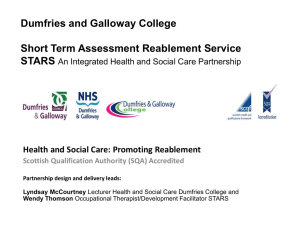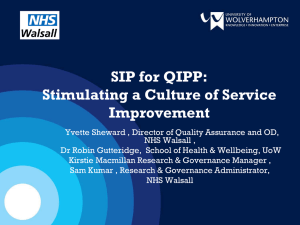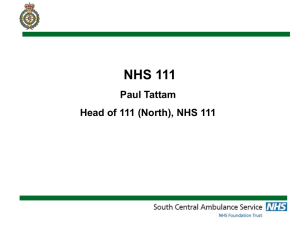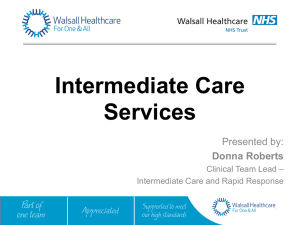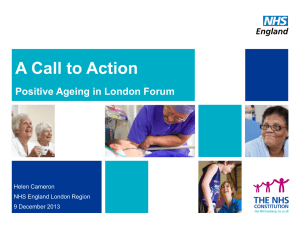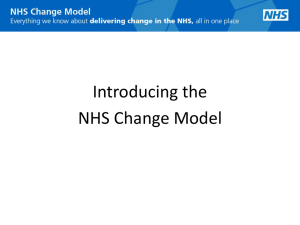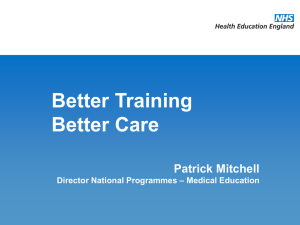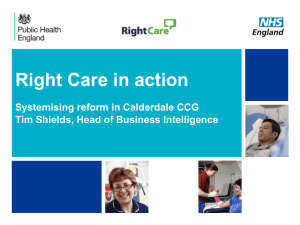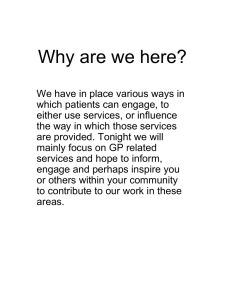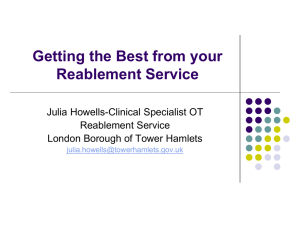Health & Social Care Integration
advertisement
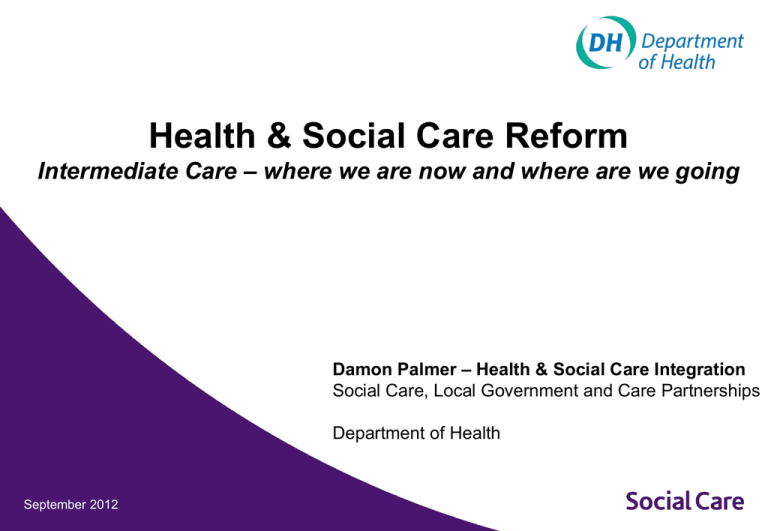
Health & Social Care Reform Intermediate Care – where we are now and where are we going Damon Palmer – Health & Social Care Integration Social Care, Local Government and Care Partnerships Department of Health September 2012 Contents 1. Introductions 2. Background & Context – the NSF for Older People 3. Case for Change 4. Where are we now? 5. Summary 2 Introductions DH Policy Lead for: 3 • Reablement Services (including Spending Review Monies) • Delayed Transfers of Care • S75 pooled funding and Care Trusts • Health & Social Care Act and Draft Social Care & Health Bill • Indicators in the Outcomes Frameworks • Intermediate Care • Integration for Health & Social Care Services (e.g. with NHS Future Forum) Background & Context National Service Framework for Older People – Aim • Provide integrated services to promote faster recovery from illness • Prevent unnecessary acute hospital admissions • Support timely discharge and maximise independent living. Standard • 4 Older people will have access to a new range of intermediate care services at home or in designated care settings, to promote their independence by providing enhanced services from the NHS and councils to prevent unnecessary hospital admission and effective rehabilitation services to enable early discharge from hospital and to prevent premature or unnecessary admission to long-term residential care. Case for Change Health Select Committee Report on Social Care Focused heavily on Integration: • Misconception “typical” service user is a healthy adult with an episode of care • Older people are the “typical” users of services – 29% of population, but 50% of GP appointments and 70 per cent of all inpatient bed days • Older people and those with long term conditions experience fragmented services • Called for integration around older people with just a single local commissioner • Called for greater merging of Government funding streams • Repeated attempts to improve integration “The Committee welcomes Government support for this objective but is concerned that progress continues to be disappointing” 5 Case for Change Changing Service Models, Behaviours and Ways of Working? • Audit Commission Report on the Health & Social Care Interface • Atlas of Variation in NHS and also for Social Care • Institute for Public Care – Oxford Brookes University • Kings Fund-Nuffield Trust Report to the NHS Future Forum – Setting a clear, ambitious and measurable goal to improve the experience of patients and service users - to be treated as a ‘must do’ priority – Offering guarantees to patients with complex needs - agreed care plan, a named case manager, access to telehealth & telecare, a personal health budget etc – Integrated care must be delivered at scale and pace. 6 • Social Care White Paper and SR Monies • Is Gov reducing barriers? Where are we now? The Health and Social Care Act Current reforms • NHS Commissioning Board new duties to promote integrated care • Health and wellbeing boards bring key stakeholders together – Duty to encourage local commissioners to work together – Will agree Joint Strategic Needs Assessment and Joint Health & Wellbeing Strategy – Consider partnership arrangements (e.g. pooled budgets) • Monitor’s core duty is now clear that patient interests always come first • Monitor has new duties to support integration where it benefits patients • HealthWatch will provide a stronger voice for patients including service design • 3 Aligned Outcomes Frameworks – Qn : More on Integrated Care? • Draft Social Care and Health Bill 7 Where are we now? Current Policy Horizon 1. Mandate to the NHS CB and Outcomes Framework 2. Financial incentives to drive integration – SR made available considerable funding to back this up – £622m in 2012-13 to PCTs to transfer to councils for spending on social care services that also benefit health – £300m in 2012-13 to PCTs to invest in reablement services to support discharge – Additional one-off £150m made available for winter pressures 3. WSD & 3 million lives programme 4. NICE QS on Discharge Arrangements 5. QIPP Year of Care and 3R Model 1. The NHS Constitution may see patients’ rights evolve 1. Community Budgets Pilots 8 Where are we now? Further Developments 1. Social Care White Paper - Taking integration further’ 2. White Paper on Care and Support – ‘Commitments on Intermediate Care’ to understand better care Pathways for: – Reablement – End of Life Care – Homeless (& housing) – Discharge Planning 3. £300m for social care over 2013-15 for new innovative integrated ways of working 1. DH created a Joint Integration Unit 2. Working with key partners (NHS CB, LGA and Monitor etc) to achieve ‘pace & scale’ 9 Summary – How this work adds value 1. Breaks the mould of previous clinical audits 2. “What gets measured gets delivered” Darzi 3. Robust approach with evidence based outputs 4. Great detail about what really goes on in the field of Intermediate Care 5. Designed and delivered by front line professionals 6. Ability to compare, benchmark and ask the right questions 10 Summary – How this work adds value 1. NAIC recommendations for DH/Gov? 2. Barriers and opportunities to ‘get on & do’? 3. Key Findings in particular: • Length of stay and impact on capacity • Demand versus supply 1. Inform policy development including reablement, IC, Delayed Transfers and Integration 2. DH-NHSCB partnership working esp. conversations for CCGs and H&WBs 3. Future Audits and look forward to continued close partnership working 11





